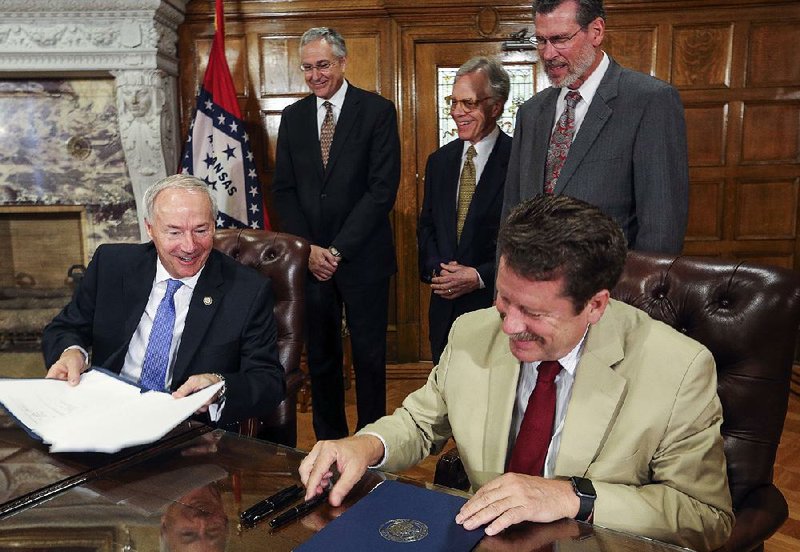Collaboration of a federal research center, five state universities and the Arkansas Department of Health will continue for at least another five years, Gov. Asa Hutchinson announced Wednesday.
He spoke at a news conference with U.S. Food and Drug Administration Commissioner Robert Califf. The pair signed a memorandum of understanding, a document that concerns the FDA's National Center for Toxicological Research in Jefferson, just north of the Pine Bluff Arsenal, which is the only such center outside the Washington, D.C., metropolitan area.
"It's startling to think that one of the largest and most important federal agencies, the FDA, has 8 percent of its employees right here in Arkansas," Hutchinson said.
It's important that those about 700 employees stay in the state and "that is done through this type of research alliance," the governor said.
The alliance includes the National Center for Toxicological Research; University of Arkansas campuses in Little Rock, Fayetteville and Pine Bluff; the University of Arkansas for Medical Sciences; Arkansas State University-Jonesboro; and the Arkansas Department of Health.
According to the memorandum of understanding, those involved will continue to share scientific capabilities, equipment and laboratory space. FDA employees will be able to serve as adjunct faculty members on college campuses and students will be provided educational opportunities.
The first memorandum was signed in August 2011. At the time, the focus was on nanotechnology research.
Hutchinson said state funds are not being dedicated to the partnership.
Researchers from academia, science-oriented groups and regulatory agencies from around the world investigate, learn and train at the 1 million-square-foot research center.
The center sits on 500 acres next to the Pine Bluff Arsenal and is the FDA's largest research facility. Its chief goal is to maintain the safety of food and medical products used in the U.S. and the world.
During the news conference, Califf said the center is working on medical techniques like so-called liquid biopsies, which could identify cancer with a blood test instead of requiring a surgeon to remove and test tissue.
Asked how the center came to be in Arkansas, Califf said that was "well before his time."
The White House announced in 1971 that the biological operations of the Pine Bluff Arsenal -- where the United States conducted its studies on germ warfare -- would become the National Center for Toxicological Research, according to an archived story in the Arkansas Gazette.
That news came a month after the Pentagon announced plans for a one-year $8.4 million program to dispose of toxic agents stored there. President Richard Nixon had ordered the biological section of the arsenal, known officially as the Directorate of Biological Operations, closed in 1969.
Metro on 09/01/2016
